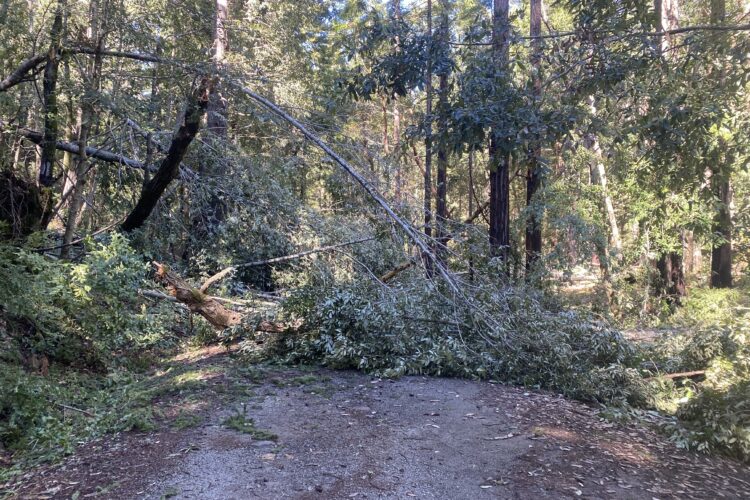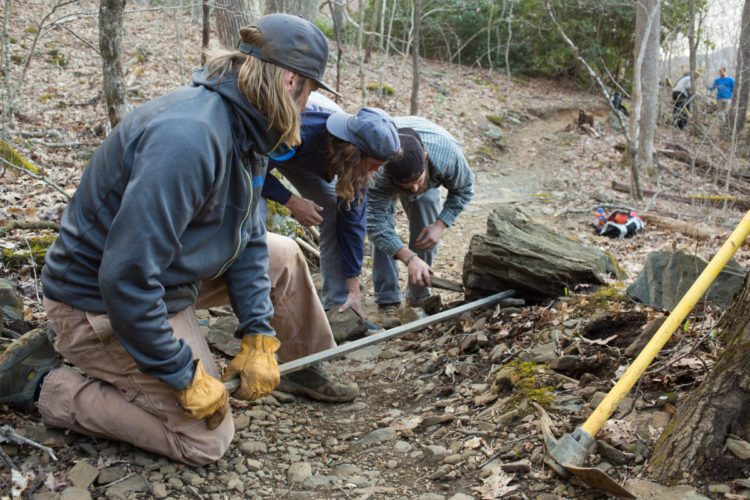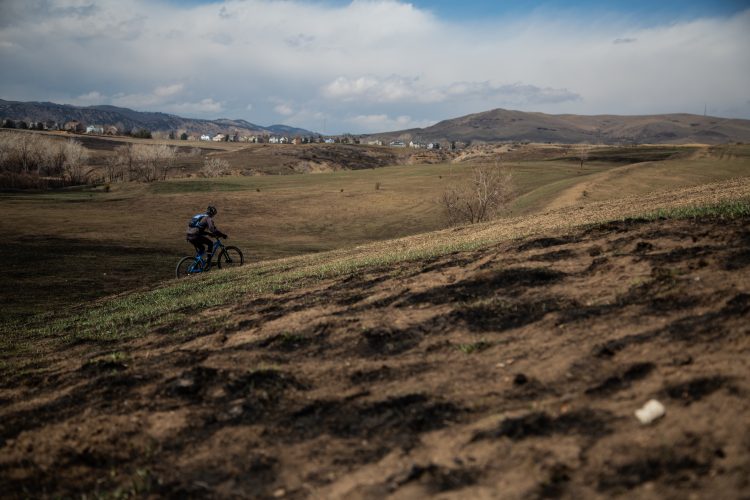
As a senior natural forestry specialist for Jefferson County leading tree thinning programs in some of Colorado’s most trafficked open spaces, Tony Auciello is aware of what the public might think when they see piles of trees that once stood tall, now lying flat, waiting for transport.
“I get where the anger is coming from,” he said. “This on the surface can seem pretty counterintuitive. We’re out here, cutting down trees to try to improve the forest. And that can be a really complicated topic.”
There’s a stark difference in the Alderfer/Three Sisters park now compared to last summer. There were notably more standing pine trees, clustered around the park providing shade for creatures underneath. The forest was more dense, creating health issues for the trees and fire risks for the houses and structures built around it.
Jefferson County Open Space is one of many land management agencies around the country, from the local to federal level engaging in the same program; cutting down trees to make the forest healthier and high intensity fires less frequent.

How many is too many trees?
To find out why so many land management agencies all over the United States are simultaneously engaging in tree thinning, it’s important to look at the history of fire suppression in the United States.
The U.S. Forest Service (USFS) was created in 1905, charged with protecting federal forests. After a few severe wildfires in the early 1900s, a conservation theory grew that believed wildfires should be suppressed to keep forests and resources intact, despite the fact that wildfire had been an important factor in healthy forests and even a tool employed by American Indians in the past.
When fires are extinguished and suppressed time after time, dead vegetation and sapling trees fill in, just like lawn weeds that aren’t whacked. The result is a growing number of living flora vying for the same amount of resources, in particular, water.
Combined with a high desert soil which doesn’t naturally hold a lot of nutrients, the trees in Colorado parks aren’t as hardy, healthy, or as big as they could be, said Auciello.

Trees around the Alderfer/Three Sisters Open Space in Evergreen, Colorado were recently marked with pink ribbons to signal which ones needed to be saved. In the area we visited, there were piles of slash, or cut branches and tree debris, and stacked piles of cut ponderosa pine as big as two small cabins.
Though the plans have serious potential to reduce the risk of wildfire danger to surrounding residents, not everyone has been happy to see stacked piles with hundreds of cut trees. Alarmed citizens have taken to the press to cite their concerns and started petitions which claim cutting trees isn’t the answer to wildfire mitigation.
Auciello said they’ve had plenty of conversations with residents who have filed formal complaints about the county’s work, and usually, their minds change after learning more about the plan.
“The people that hate my work hate it because their heart is in the right place, their mind just hasn’t caught up yet,” he said. “Their education hasn’t.”

What’s in store across the West
Jefferson County began work at the park this summer, but their latest Forest Health Plan dates back to 2022 and cites the importance of not only tree and forest health, and the growing number of lives and structures in the wildland-urban interface, but recreation and clean drinking water.
Denver Water dredged a reservoir after the 2002 Hayman Fire, because runoff had deposited sediment and reduced the reservoir’s capacity, according to the Summit Daily. The project cost $30 million. The USFS also cites water health as an urgent reason to act on its latest, massive initiative.
In January of 2022, the USFS published its Wildfire Crisis Strategy with similar goals across the Western U.S. The highest risk firesheds are near large population centers and the largest wildland-urban interfaces: Los Angeles and San Diego, Portland and Seattle, Salt Lake City and Southwest Utah, Phoenix, and the Front Range of Colorado.
The 10 initial picks for landscapes were informed by which areas had the highest risk firesheds and which projects could be scaled up. The largest project area is in California, with four million acres up for treatment in the mountains which parallel the metropolis sprawling from Los Angeles to San Diego.
What does it mean for trail access?
National and local forests across the West are sporadically closing access to some trails as these thinning projects take place. Some may be closed for weeks or months and some may not be impacted at all.
At Alderfer/Three Sisters Park, Auciello sees it as an investment. The park has been closed in sections for the majority of the week until the spring of 2024.
“We’re closing this four days a week to do our work, but it’s still open three days,” he said. “And we’re really only going to be here like two and a half months on this section, and then we’re going to move to another part of the park and then the park will be ready for a fire. And if a fire does come, it’ll be closed for a little while we make sure things are safe, but we could have people back in here the next year or even that year.”
The biggest effect we’ve seen on trail access as related to fires is the familiar story of a fire sweeping through a forest, closing a trail network for a short period and re-opening. The following year, the same area may see huge amounts of rainfall, leading to erosion and mudslides wiping a trail out entirely.

It’s just like mowing the grass
Jefferson County uses a topographic wetness index (TWI) to determine the target areas for thinning. These models show the topography of the park, where water accumulates, and the soil conditions. In parts with a high TWI, they don’t thin as much because trees are less likely to burn.
In parts where they are thinning, the county contracts work out to a private company which uses a harvester to chop a tree at the base and shave its limbs off in about 30 seconds. A good tree feller needs about ten minutes to do it by hand. The harvester moves up and down in rows, like a lawn mower grabbing trees within 35 feet of its path in any direction.


Trees are either sorted and transported by the contractor to another part of the state where a portion is used for low-value lumber. JeffCo doesn’t make money off of the sales, but other land management agencies can. Colorado’s trees are notoriously bad for timber harvesting. Some trees are also sorted into slash piles and a masticator will chew the slash up and spit it into a pile across the forest floor.

Though the county has taken some heat for for removing older trees, Auciello says most of the trees they’re removing are about 150 years old, which goes back to the time when Europeans settled and started suppressing fires. In Colorado, old growth trees start at about 200 years old, he said.
When the county modeled their forestry plan in a computer program, their estimates showed that under a high intensity fire, they would lose 99% of the trees in the park, but after treatment, it’s reduced to about 50%.

A different need for forest health
Hood River, Oregon gets about 30″ of precipitation annually. That’s not a small amount and forest fires are not the primary concern for land managers, at least not those at Post Canyon. But foresters are still taking the same approach to improve forest health as those in the high desert mountains of Colorado.
Tim Mixon, the president of the Hood River Area Trail Stewards (HRATS) has been mountain biking the Family Man area of Post Canyon for years and believed that something needed to be done to improve the forest health.
“There were way too many trees,” said Mixon. “I had gone out there with a couple of foresters that weren’t with Hood River County and they basically told me, ‘if you take 30% of the trees out the forest will be healthier’ and that’s essentially what the county did and made some money on it too.”
The Post Canyon trails sit on the Hood River County Tree Farm, county-owned land that generates about 30% of county revenue, or roughly $4 million a year, and funds public safety services, infrastructure, and more through timber harvests.
The trees are on a 90-100 year lifecycle according to the county. As they mature, the county conducts pre-commercial thinning to harvest the best trees at that time, then the remaining trees grow even healthier when it’s time for the final harvest.
Mixon and the HRATS were pushing the county to rebuild some of the Family Man trails, a more beginner-friendly spot on the mountain frequented by kids and novice riders, but it didn’t make sense to rebuild the trails knowing that when it’s time for pre-commercial thinning, the harvest and machinery involved would destroy the trails.
This year proved to be the perfect time and HRATS and the county planned for both projects to take place in sequence. The county removed about 30% of the trees at Family Man, installed a new road, and HRATS rebuilt the Family Man trails.
Family Man might look fresh and raw at the moment and riders are getting accustomed to a change in scenery, but Mixon is optimistic about the future.
“I think in three years, it’s going to be stunningly gorgeous,” he said. “You’re going to have dedicated trails, it’s going to be designed well enough that people are going to have nice foliage on the ground and a really well designed skills park.” Vegetation on the ground had been spotty in parts before, they say.
T.J. Moloney, the recreation program manager for the Hood River County Forestry Department sees all the positive elements of trail use and responsible forestry coming together in this project, even if wildfire is a background risk for them.
“Wildfire mitigation is an added bonus but the way I saw it is that the primary purpose of it is for forest health,” he said. “And that also directly contributing to recreation in the area, that point wasn’t lost in the process.”
Show your Support
Become a Singletracks Pro Supporter today and enjoy benefits like ad-free browsing.
With your support we can provide free worldwide trail information and original content created by our team of independent journalists.





















4 Comments
Nov 24, 2023
Nov 21, 2023
Nov 23, 2023
Nov 26, 2023